IF 4.3
3区 材料科学
Q2 MATERIALS SCIENCE, MULTIDISCIPLINARY
引用次数: 0
摘要
本研究介绍了在相同工艺条件下通过水热法获得的基于苯-1,3,5-三羧酸(H3BTC)的金属有机框架(MOFs)(MBTC(M = Fe、Mn、Co、Ni、Cu、Zn;M2+Cl2-4H2O 前体))的组成(块体和表面)、结构(晶体和局部)和杀菌性能的研究结果。使用了 XRPD、XAS、XPS、SEM 和 FTIR 方法。测定了 Fe3+、Cu2+(Jahn-Teller 离子)、Zn2+ 的形式电荷 (FC),并首次测定了 Co(3,2)+、Ni(3,2)+ 和 Mn(3,2)+(Mn3+ Jahn-Teller 离子含量较高)的混合 FC。研究表明,在 M - BTC 体系中,根据 FCM 的不同,会形成具有不同结构类型的 MOFs(MIL-100,含铁,sp.Fd3m; HKUST-1 with Cu, sp.Fm3m;MBTC,M = Mn、Co、Ni,Sp. Gr. P 3‾;MBTC,Zn,Sp. Gr. C2),其中 M 离子的配位环境各不相同。根据М金属的性质,所获得的结果可以将 MOF 结构分为 4 组。这样就可以根据М离子的电子结构预测 MBTC 的拓扑结构类型。对甲基溴四氯化碳抗菌活性的研究结果表明,细菌的杀菌特性与М离子的电子结构之间可能存在联系。本文章由计算机程序翻译,如有差异,请以英文原文为准。

Impact of transition metals (M=Mn, Fe, Co, Ni, Cu, Zn) on the formation of local and crystal structure of MBTC phases
In this work, the results of studying the composition (bulk and surface), structure (crystal and local) and biocidal properties of metal-organic frameworks (MOFs) based on benzene-1,3,5-tricarboxylic acid (H3BTC), called MBTC (M = Fe, Mn, Co, Ni, Cu, Zn; M2+Cl2·4H2O precursor), obtained by a hydrothermal method under the same process conditions were presented. XRPD, XAS, XPS, SEM, and FTIR methods were used. The formal charge (FC) was determined for Fe3+, Cu2+ (Jahn-Teller ion), Zn2+ and, for the first time, a mixed FC was determined for Co(3,2)+, Ni(3,2)+ and Mn(3,2)+ (with a higher content of Mn3+ Jahn-Teller ions). It was shown that in the M - BTC system, depending on FCM, MOFs with different types of structures are formed (MIL-100 with Fe, sp. gr. Fd3m; HKUST-1 with Cu, sp. gr. Fm3m; MBTC with M = Mn, Co, Ni, sp. gr. P ; MBTC with Zn, sp. gr. C2), in which the coordination environment of M ions is different. The results obtained made it possible to divide MOF structures into 4 groups depending on the nature of the М metals. This allows predicting the topological structural types of MBTC based on the electronic structure of М ions. The results of studying the antimicrobial activity of MBTCs indicate a possible connection between the biocidal properties of bacteria and the electronic structure of M.
求助全文
通过发布文献求助,成功后即可免费获取论文全文。
去求助
来源期刊

Materials Chemistry and Physics
工程技术-材料科学:综合
CiteScore
8.70
自引率
4.30%
发文量
1515
审稿时长
69 days
期刊介绍:
Materials Chemistry and Physics is devoted to short communications, full-length research papers and feature articles on interrelationships among structure, properties, processing and performance of materials. The Editors welcome manuscripts on thin films, surface and interface science, materials degradation and reliability, metallurgy, semiconductors and optoelectronic materials, fine ceramics, magnetics, superconductors, specialty polymers, nano-materials and composite materials.
 求助内容:
求助内容: 应助结果提醒方式:
应助结果提醒方式:


